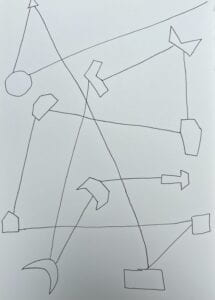Generative art, as described in the reading, encompasses a wide range of creative processes that involve the use of algorithms, rules, randomness, and natural systems to produce artwork. The author demonstrates various examples of P5.js that rely on randomness and commands like “random()” to create art. However, as the author emphasizes, generative art is not limited to computer-generated works; it can also be achieved through pure randomness and the application of rules, even in handmade drawings.
Computational generative art aligns with the artworks I created for mini projects 1 and 2. In the first project, I needed to transform a line art version of my room into a coded version consisting of simplified polygons. To do this, I calculated the coordinates of each shape and followed a set of instructions to achieve my desired drawing. While there was little randomness in this process due to my specific artistic vision, it demonstrated how computational rules could guide the creation of intricate artworks.
In contrast, the second mini project introduced more randomness. We were tasked with generating an interactive drawing where a line would move between different points, allowing room for experimentation with color, line thickness, and shape. I used the “random()” function to create a multicolored line every time the “f” key was pressed, introducing an element of chance and unpredictability into the artwork.
My drawing system involves starting with a blank sheet of paper and drawing a line from one of the corners. Once the line reaches its endpoint, a random geometric shape is drawn. This process continues, with each line originating from the previous geometric shape and ending with the addition of another random geometric shape. The size and complexity of the geometric shapes vary with each iteration.

This drawing system can be considered generative because it follows a clear set of systematic rules. These rules include instructions for drawing lines, geometric shapes, and their connections, providing a structured framework for generating the composition. While the rules provide structure, they also allow for complexity and variation. The interplay between the rules and the artist’s choices results in a wide range of possible outcomes, making each artwork unique and unpredictable.
When creating these rules, my thought process involved visualizing the final image in my mind. I wanted to ensure that shapes were not repeated and that they became more complex over time, enhancing creativity while maintaining an element of unpredictability in the artistic process.
Leave a Reply